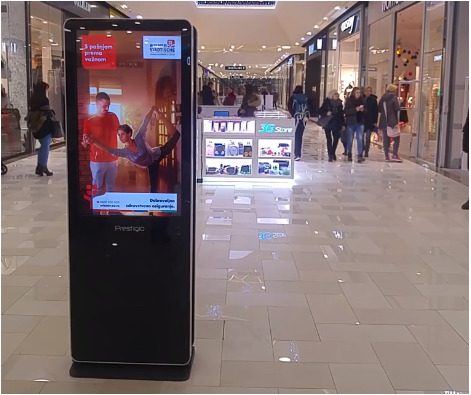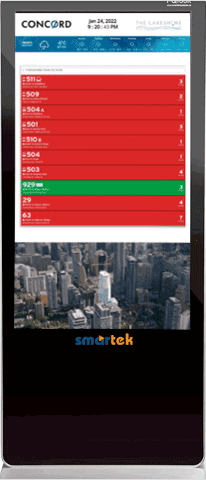Digital signs and wayfinding kiosks are being used by businesses and organizations more and more. Digital signage is a technology that shows people information through digital images and sounds. Wayfinding kiosks are a type of technology that can help people find their way around and learn about the area. They can be put in airports, malls, and other prominent public places.
Digital signs and wayfinding kiosks are tools that make it easy for people to find information and services quickly. Most of the time, they are used in public places like hospitals and airports to tell people about the area or the services available. Some kiosks can also be used to show ads and sell things.
Workplaces with a lot of employees have always had to have signs to help people find their way.
It’s still crucial in workplaces today, but how it’s dealt with has changed. In the past, there were massive towers with fancy phone books in the lobby or huge corporate campuses with “Welcome!” signs. With the help of wayfinding kiosks and digital signs, you can tell people where they are and how to get to where they want to go.
How did Wayfinding kiosks Come to you?
Digital signs and kiosks that help people find their way around quickly become essential tools for businesses of all sizes. With the need for information growing, these devices make it easier and faster for customers to get information.
Digital signage helps businesses reach their goals by giving them an excellent way to communicate with and involve customers. Customers and employees can use wayfinding kiosks to learn about products and services and find their way around an office.
Digital signs and kiosks helped people find their way around for a while and took off in the 2000s. Digital information kiosks in airports, train stations, and other busy places were the first kind of wayfinding kiosks. But over time, they have also become common in stores, hospitals, and other places where people need to find their way.
How did digital signage and wayfinding kiosks come about?
Signs and kiosks that help people find their way are becoming increasingly popular. These systems make it easy for businesses to share important information with their customers. They are easy to use and can be changed to fit the needs of any business. They are also cost-effective because they don’t need expensive hardware or software.
A digital wayfinding kiosk lets visitors, guests, and customers find information and directions without asking a worker for help. Instead of asking an employee for help, customers can use a digital wayfinding kiosk to find information and directions.
You can get help finding your way with interactive maps and SMS or hand-off services from a kiosk to a phone.
Guests, visitors, and customers can find their way around unfamiliar areas with the help of wayfinding kiosks, which can be customized with multiple features.
- Instructions for navigating indoors with animated paths and step-by-step instructions.
- The kiosk hardware integrates seamlessly with Smartech’s wayfinding software.
- SMS (mobile text) integration to send GPS directions and maps from kiosk to phone.
- Google Maps can be installed on an outdoor wayfinding system, which can provide directions to campus buildings and amenities based on instant traffic conditions.
and directions to buildings and other amenities on and off campus.
How can digital signage and wayfinding kiosks benefit your business?
Digital signs and kiosks that help people find their way are essential to marketing to customers and getting information from them. They can be used in many places, like stores, airports, hospitals, schools, and more. Digital signs can be static or interactive, and wayfinding kiosks make it easy to get to important information quickly. Both types of signs can help reduce the time customers have to wait and improve their experience.
Digital guidance maps aren’t the only good thing about wayfinding systems. These things are:
1. Make people less stressed and happier.
When a user gets to a place and finds what they want quickly and easily, they are happier and less likely to be unhappy.
2. Giving the brand a boost
As the user interacts with the map, the brand logo reinforces the presence of the brand or digital company.
3. Human Resources can concentrate on more crucial duties.
With computerized orientation maps, there may be a better way to use people. Wayfinding systems give people the information they need based on their own needs.
- Being able to send urgent messages is
Thanks to the wayfinding systems, urgent messages can be sent out from a central location.
- Information in real-time, on demand
Digital signage makes it easy to change the information that is shown. Content management systems make it easy to change content that already exists.
- Run promotional kinds of stuff
You can create ads for products, services, and upcoming events on wayfinding systems.
- Adaptability
There are different ways to show information, so people can choose which information they want to see.
- Simpleness
Wayfinding systems help people who need help find their way right away. The information given must be clear and easy to understand.
What are some common use cases for digital signage and wayfinding kiosks?
Digital signs and wayfinding kiosks are often used in businesses to give employees and customers important information. They can be used to tell people about the business, its products and services, and more. Kiosks can also help people find their way around a building or business.
The Actual Role of Wayfinding Kiosk
The goal of wayfinding kiosks is to help people get where they need to go by telling them where they are and how to get there. This could be done by putting the current location on a 2D map. In this model, different types of floors are shown in different colors. 2.5D is the most popular and high-end choice. This shows the map from a bird’s-eye view and gives the picture more depth. 2.5D can give a clearer picture of the place and accurately show the difference between floors.
Wayfinding kiosks are often found in large shopping malls, where people looking for a particular store can use them to get directions. Airports often have these kinds of kiosks because people who don’t fly often find it hard to get around independently.
Wayfinding kiosks are also used in large workplaces to help employees and visitors find their way.
In buildings with multiple tenants, a wayfinding kiosk can send your employee or visitor straight to the correct office, so they don’t have to wait at the front desk.
The installation of wayfinding kiosks in retail settings can be an excellent way to retain customers. Eighty percent of customers would instead use their phone or a kiosk to get help finding an item.
For many reasons, digital signs and wayfinding kiosks are taking the place of their static counterparts. Digital signage can be set up quickly and can be used by guests. Both visitors and employees can use devices to help them get around.
Simplicity
People who need help getting around at the office can use digital kiosks and signs.
Take, as an example, the biggest shopping mall. Without a sign telling you where to go, you won’t be able to find the elevator or bathroom. It’s easy to figure out where to go when there’s a kiosk with interactive directions. You can walk up to the kiosk and pick “Washroom at the corner of that floor” from the list. You’re done! You’ll be shown how to do things. Whoever you meet won’t matter. There are no signs or landmarks to help you find your way. It is a simple, step-by-step plan.
Accessibility
Digital wayfinding is more than just getting from one place to another. Digital wayfinding can show things that can’t be shown on traditional signs. For example, people can use digital information kiosks and company directories to find people, not just rooms. You can look for things like company departments, amenities, and exits through the menus.
Implementation
Interactive navigation systems are easy to add to larger systems. When Slack is linked to these systems, meetings and room reservations can be set up automatically. You can also use computers to book rooms. The technology that helps people find their way is a mix of digital management and physical monitoring.
Why should you use digital wayfinding Kiosks?
Wayfinding Kiosks do more than just help people find their way. They are also important parts of an eco-friendly smart city. Pollution from cars is making it more and more important to be able to walk. So, a key part of the city’s ability to meet the needs of pedestrians has good signs to help people find their way.
People can get where they need to go faster and with more confidence with this and the wayfinding systems. People are also less likely to get lost and are encouraged to walk.
If you want to improve people’s lives, whether inside or outside, you might want to update the guidance tools to a digital platform that people can interact with.




































